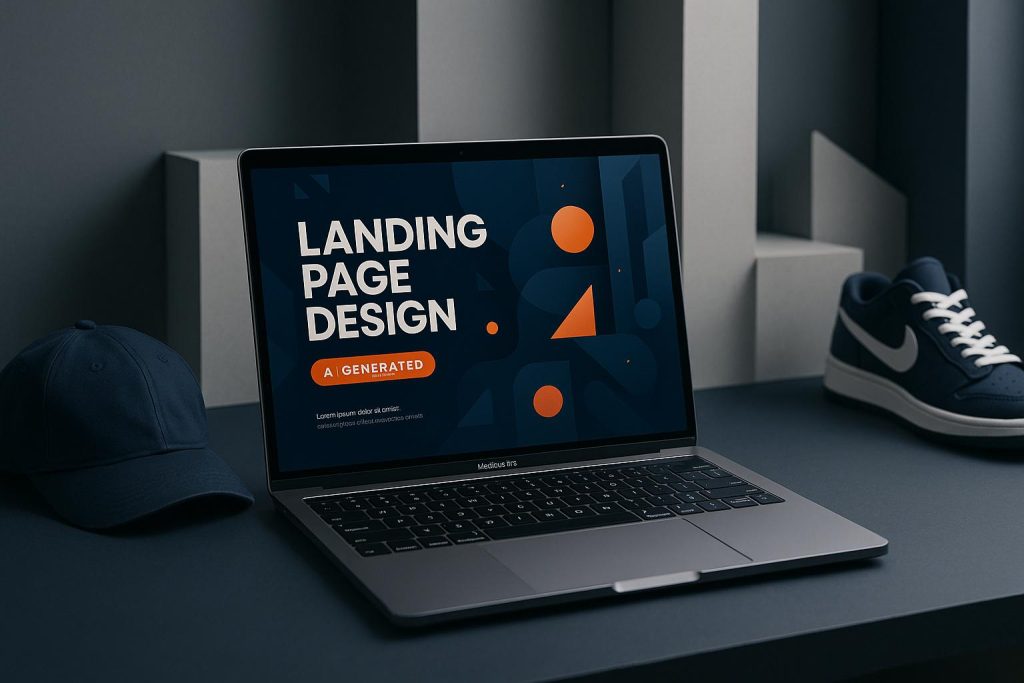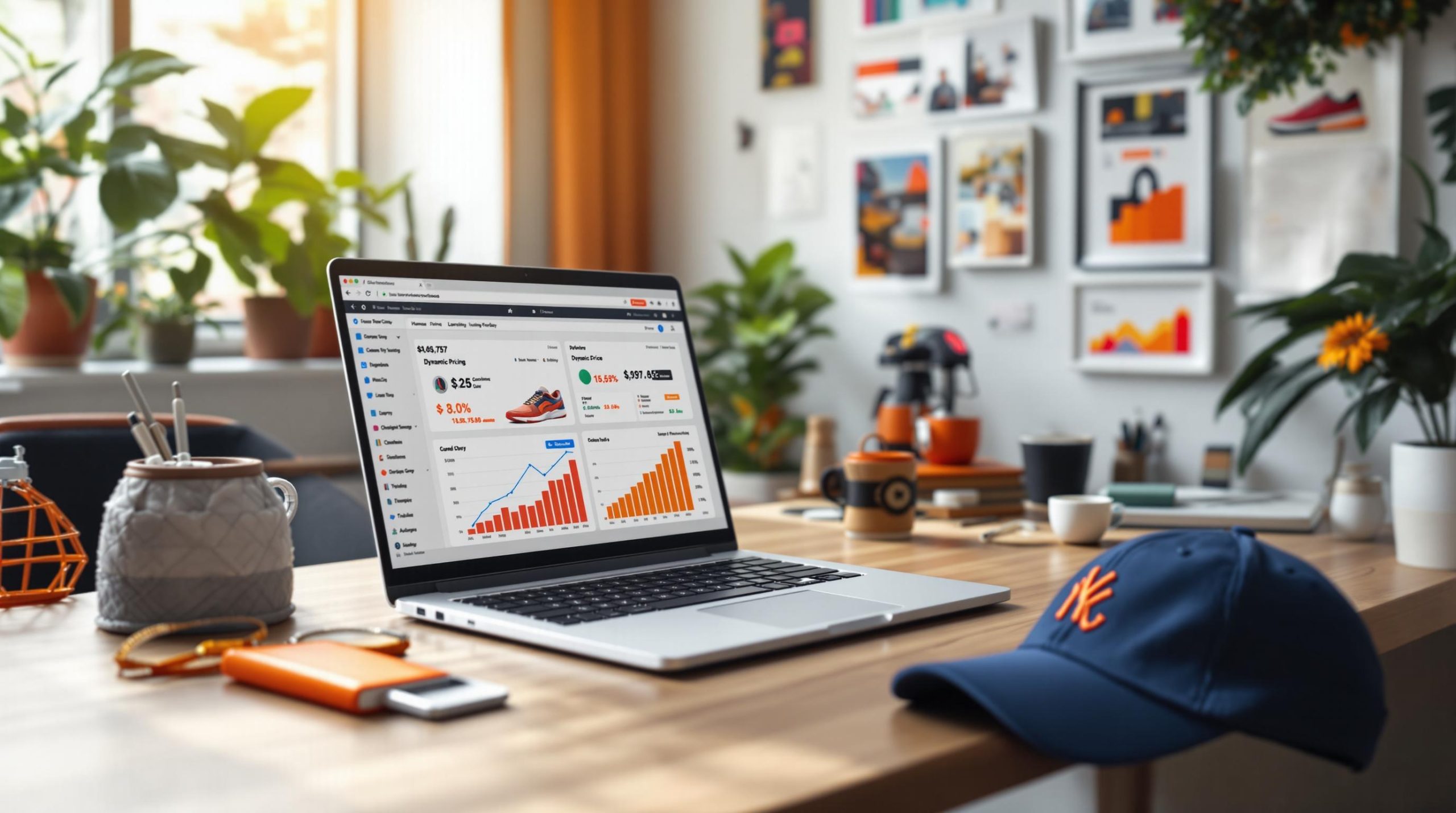By 2025, AI tools are transforming how landing pages are created. They automate tasks like copywriting, layout design, and optimization, saving time and boosting conversions by up to 20%. Whether you’re a solo entrepreneur or part of a marketing team, these tools make it easier to build professional, high-performing landing pages without needing advanced design skills.
Here’s a quick look at the standout tools:
- Team-GPT: Built for team collaboration, offering AI-driven insights and shared workspaces.
- PageGPT: Generates complete landing pages from a product description.
- Canva: Popular for its ease of use and AI-enhanced design features.
- Unbounce: Focused on conversion optimization with tools like Smart Traffic.
- MailerLite: Combines email marketing with AI-powered landing page creation.
- Landingi: Offers AI-driven design suggestions and a large template library.
- Writesonic: Creates landing pages using AI-generated copy and layouts.
- Lovable: Fully automates page creation with user-friendly customization.
- Hostinger: Includes an AI builder integrated with hosting services.
- SiteKickAI: Quick page creation without account setup, ideal for fast launches.
Each tool caters to specific needs, from beginners needing simplicity to marketers focused on advanced conversion strategies. For a quick comparison, check out the table below.
Quick Comparison
| Tool | Key Features | Starting Price (USD/month) | Best For |
|---|---|---|---|
| Team-GPT | AI collaboration, team workflows | $10 | Marketing teams |
| PageGPT | Chat-based page generation | $19 | Solo entrepreneurs |
| Canva | AI-enhanced design, templates | Free | Small businesses |
| Unbounce | Smart Traffic, A/B testing | $99 | Conversion-focused marketers |
| MailerLite | Email integration, drag-and-drop builder | Free | Lead generation campaigns |
| Landingi | AI design suggestions, 400+ templates | Free | SMBs, agencies |
| Writesonic | AI copywriting and layouts | $16 | Content-heavy campaigns |
| Lovable | Automated design, customization options | $29 | Fast, polished results |
| Hostinger | AI builder with hosting | $2.99 | Budget-friendly users |
| SiteKickAI | Instant launch, no login required | $19 | Quick, simple page launches |
These tools simplify the process of creating landing pages, helping businesses save time and money while improving marketing outcomes. Whether you’re focused on speed, collaboration, or conversion rates, there’s an AI tool tailored to your needs.
Top 5 ways to build a landing page in 2025 (no-code vs AI)
1. Team-GPT
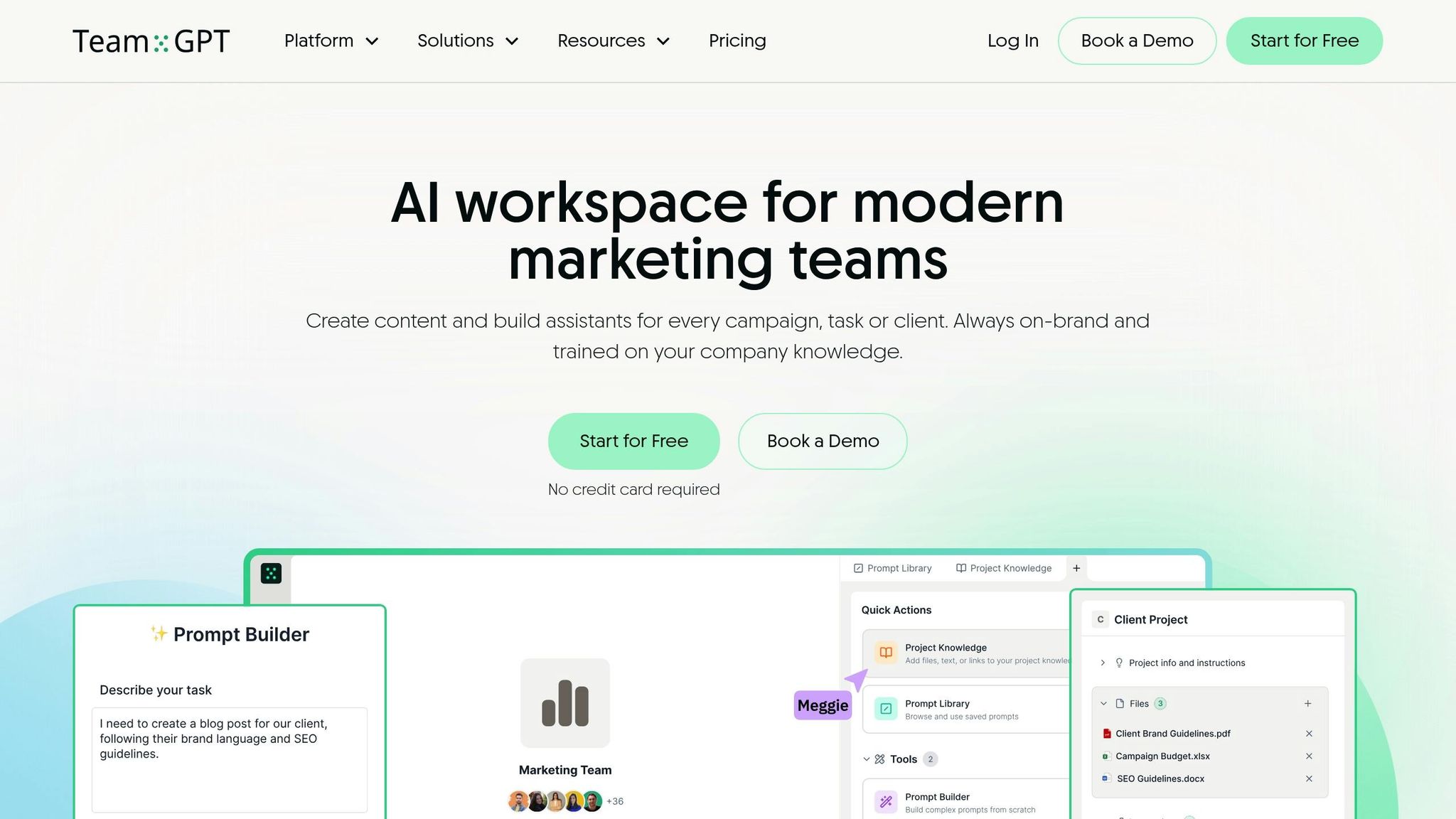
Team-GPT is a platform built for teams, designed to simplify landing page creation by combining teamwork with AI-driven insights. It’s not your typical single-user tool – it’s specifically crafted to help marketing teams collaborate seamlessly while using AI to develop landing pages that drive conversions. Let’s take a closer look at how Team-GPT integrates AI to enhance design, teamwork, and customization.
AI-Powered Design Features
Team-GPT takes the hassle out of design tasks by automating essentials like writing headlines, crafting copy, and creating call-to-actions. It doesn’t stop there – its AI assistant provides real-time suggestions to fine-tune designs, ensuring that every element aligns with conversion-focused strategies.
The shared workspace is a game-changer for marketing teams. It brings together account managers, copywriters, and designers, allowing them to work in sync and maintain consistency across campaigns. This collaborative environment makes refining landing page elements a team effort.
Another standout feature is the smart template generator. By inputting campaign objectives and audience details, users can get multiple design options tailored to specific conversion goals. This saves time while offering flexibility in design approaches.
Who Can Benefit From Team-GPT?
Team-GPT is a perfect fit for marketing agencies and internal marketing teams that need to churn out high-quality landing pages quickly. Digital marketing agencies, in particular, will appreciate the platform’s collaborative tools, which help teams deliver polished results faster and boost client satisfaction. It’s also a valuable asset for enterprise-level marketing teams managing complex campaigns with multiple contributors.
Customization Made Simple
The platform’s user-friendly interface allows teams to tweak templates and layouts in real time, all while receiving AI-driven guidance. This makes it easier to adapt landing pages to shifting campaign needs, ensuring designs stay relevant and effective.
2. PageGPT
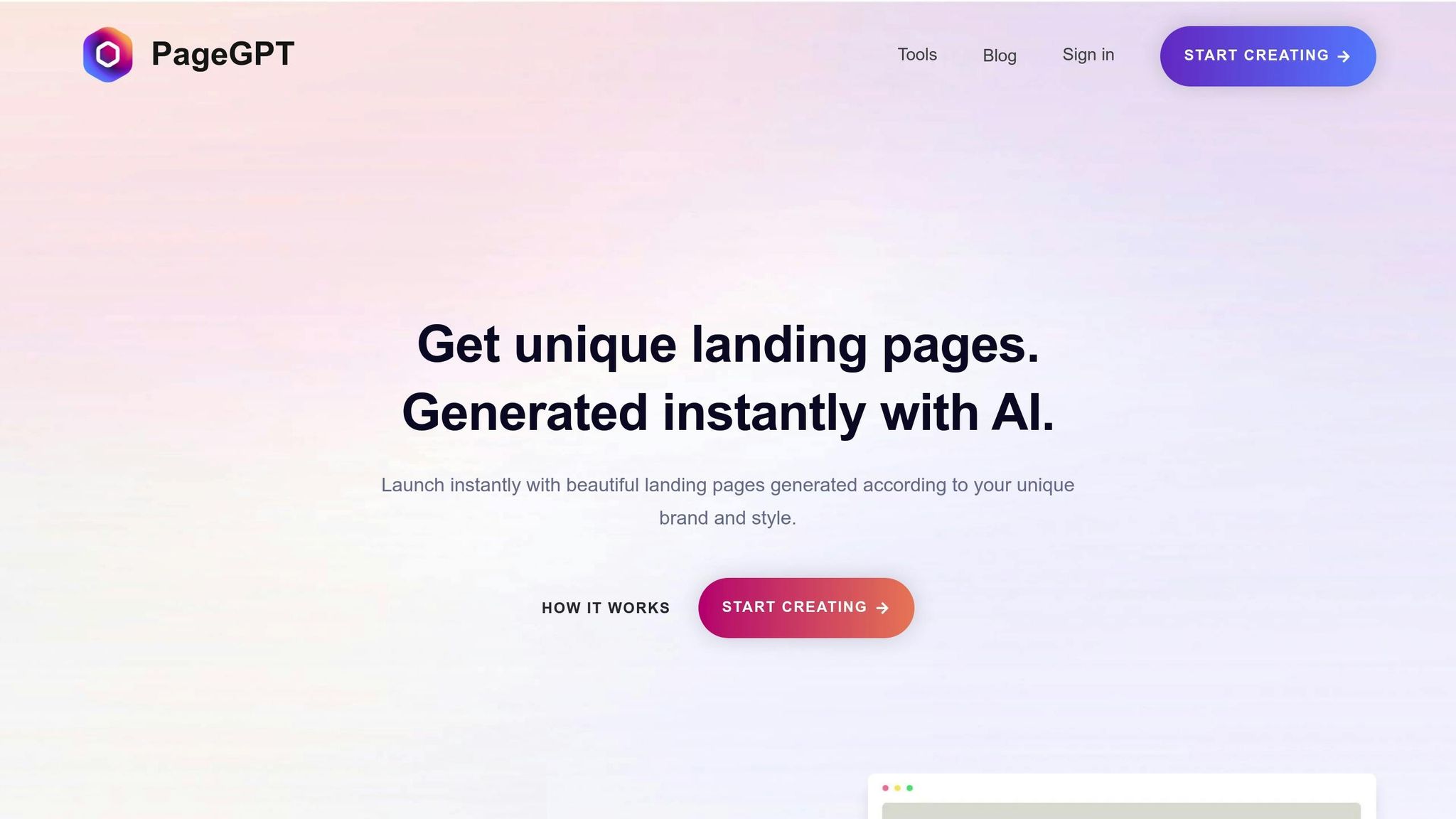
PageGPT is an AI-driven landing page builder designed to make creating professional pages fast and straightforward. Instead of relying on traditional drag-and-drop tools, it generates fully functional landing pages – including layouts and persuasive copy – directly from a single product description, saving time and effort.
AI-Powered Design Features
PageGPT combines design and copywriting automation in a single platform. With just a product description, it generates a complete landing page that includes headlines, body text, and call-to-action buttons. This approach eliminates the usual back-and-forth between designers and copywriters, delivering a cohesive and polished result instantly.
The AI ensures that pages look professional across all devices – desktop, tablet, and mobile – without requiring additional adjustments.
Who Benefits from PageGPT?
PageGPT is perfect for anyone who needs high-quality landing pages quickly and efficiently.
- Marketers, small business owners, and entrepreneurs can use it to create professional pages without needing advanced design skills or large budgets.
- Solo entrepreneurs launching new products will appreciate its ability to deliver polished pages when resources are limited.
- Small businesses can produce multiple page variations in minutes, making it ideal for time-sensitive campaigns.
- Startups can test product ideas and gather market feedback without investing heavily in design.
Customization Options
Though PageGPT focuses on automation, it still allows for some level of customization. Users can tweak colors, fonts, and layout elements to better align with their brand identity. While it doesn’t offer the same level of granular control as traditional design tools, this trade-off prioritizes speed and simplicity – perfect for those who need to launch quickly rather than focus on pixel-perfect details.
To get the best results, provide clear and detailed product descriptions. This helps the AI generate landing pages that are targeted and effective.
3. Canva

Canva has made creating professional-looking landing pages easier than ever, thanks to its AI-driven design tools. With over 170 million monthly active users worldwide as of 2025, it’s become a favorite for marketers and small business owners who need visually striking pages without hiring a designer.
AI-Powered Design Features
Canva’s Magic Design tool simplifies the process of building landing pages. Just provide a brief description of your campaign goals or target audience, and the AI generates multiple layout options in seconds. Beyond layouts, Canva offers tools like background removal, image enhancement, and text-to-image generation, helping users create custom visuals without relying on stock photos.
The platform also analyzes your input to suggest headlines, body text, and call-to-action phrases optimized for conversions. A 2024 survey found that Canva’s AI tools cut landing page creation time by 60%, making it a time-saver for busy teams. Plus, its pricing plans make it accessible for a wide range of users.
Pricing (in USD)
Canva provides three pricing options:
- Free Plan: $0/month, which includes basic templates, the drag-and-drop editor, and limited AI features.
- Pro Plan: $14.99/month (or $119.99/year) with advanced AI tools, premium templates, brand kits, and expanded storage.
- Teams Plan: $29.99/month per user, offering enhanced collaboration tools, workflow management, and team-specific features.
For most landing page projects, the Pro Plan delivers excellent value. It includes over 6,000 premium templates and full access to Canva’s AI features, all at a fraction of the cost of specialized landing page builders.
Use Cases (Target Audience)
Canva is a game-changer for small business owners, solopreneurs, and marketing teams who don’t have dedicated designers. It’s perfect for creating landing pages for product launches, event sign-ups, lead generation, and email campaigns. Social media managers also find it useful for designing pages that align with their campaign aesthetics across different platforms.
Startups, in particular, appreciate Canva’s ability to generate multiple landing page variations quickly. This allows them to test different designs without stretching their budgets.
Customization and Flexibility
Canva’s drag-and-drop editor makes customization straightforward while offering a wide range of design possibilities. The Brand Kit feature ensures consistent branding across all campaigns, from colors and fonts to logos – a must for businesses juggling multiple projects.
Users can tweak every element of their designs, from typography and spacing to layering and custom layouts. Collaboration is seamless, with tools that let team members provide real-time feedback and make adjustments on the fly.
While Canva doesn’t come with advanced features like built-in A/B testing, its strength lies in its flexibility and ability to produce visually engaging pages that resonate with audiences.
4. Unbounce
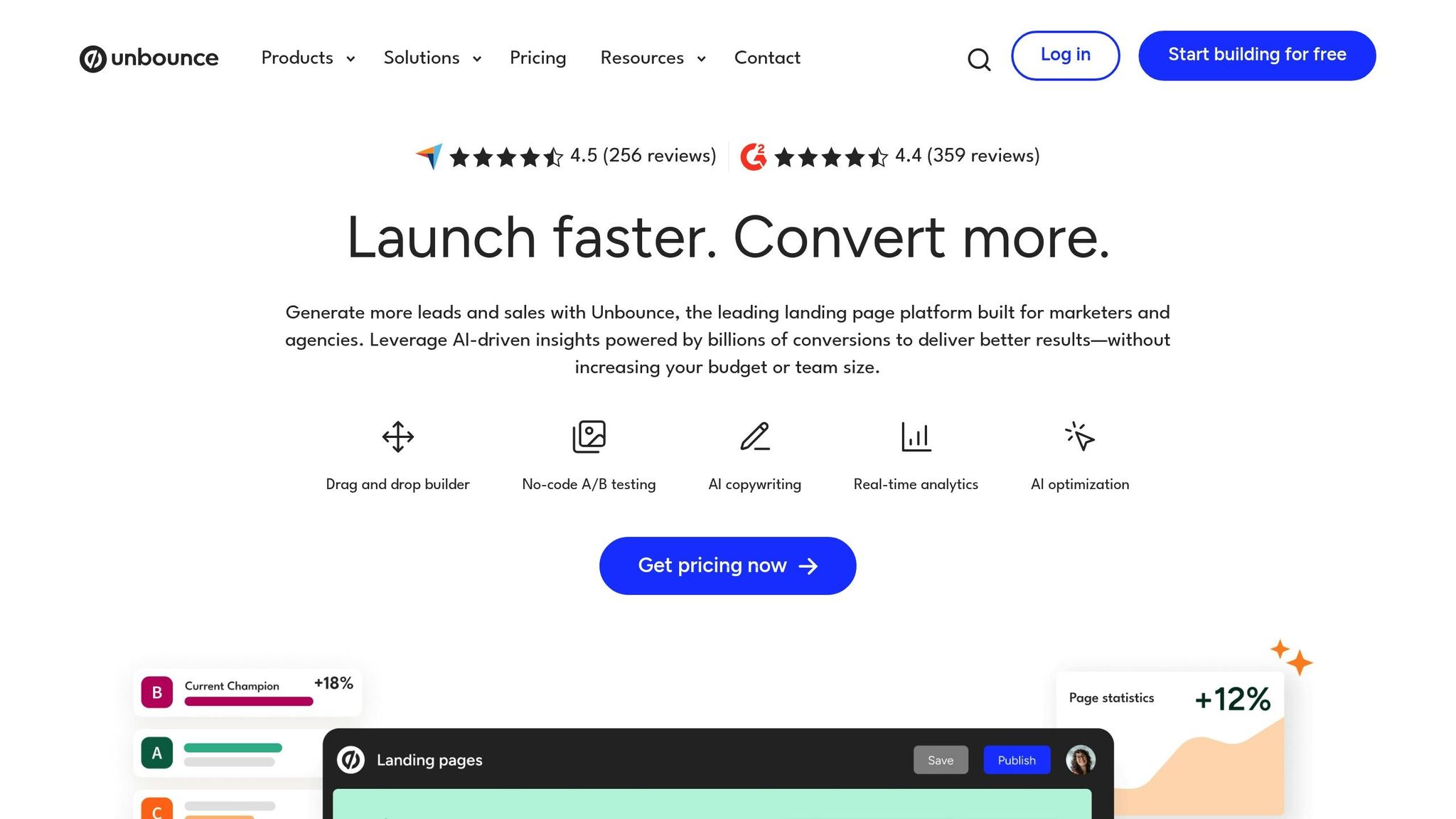
Unbounce uses AI to enhance landing page performance, earning its reputation as a go-to platform for conversion-focused landing page design in 2025. Combining AI-powered tools with over a decade of expertise in conversion science (since its launch in 2009), Unbounce offers features that make creating high-performing landing pages easier and more effective.
AI-Powered Design Features
One of Unbounce’s standout tools is Smart Copy, an AI-driven assistant that provides over 30 copy templates tailored for landing pages. This tool helps craft headlines, calls-to-action, and body text that align with your campaign goals and audience. Smart Copy allows users to generate, refine, and remix content quickly, offering multiple variations for testing without the endless brainstorming sessions. It applies proven conversion techniques to deliver persuasive messaging.
Another key feature is Smart Builder, which uses machine learning to recommend layouts optimized for your specific industry and campaign type. Paired with Smart Traffic, Unbounce takes optimization further by automatically directing visitors to the landing page variant most likely to convert. This feature leverages real-time data and visitor behavior to maximize results.
For example, a digital marketing agency tested Smart Traffic during a client’s ad campaign and saw impressive results. By routing visitors to the top-performing landing page variant, the campaign’s conversion rate increased by 30%, outperforming traditional A/B testing methods.
Pricing (in USD)
Unbounce offers flexible pricing to cater to businesses of all sizes, starting with a 14-day free trial. After the trial, plans begin at $99/month:
- Launch Plan: $99/month, includes unlimited landing pages, up to 500 conversions, and 20,000 visitors per month.
- Optimize Plan: A higher-tier option with increased limits and advanced integrations.
- Accelerate Plan: A premium plan offering priority support and maximum capabilities.
Use Cases (Target Audience)
Unbounce is designed for marketers, agencies, and businesses aiming to boost conversions through data-driven design. It’s a great fit for teams lacking in-house design or copywriting resources, as its AI tools handle much of the heavy lifting.
Digital marketing agencies benefit from tools like Smart Traffic and Smart Copy, which save time on campaign optimization. E-commerce brands can leverage Unbounce’s conversion-focused features to drive sales, while small and medium-sized businesses appreciate its ability to create professional landing pages without hiring specialists.
The platform shines in lead generation, product launches, and paid advertising campaigns. Its ability to test and optimize campaigns automatically makes it especially valuable for businesses running multiple campaigns at once.
Customization and Flexibility
Unbounce’s drag-and-drop editor and support for custom code (HTML, CSS, JavaScript) provide users with plenty of design flexibility. Additional features include custom domains, dynamic text replacement, and advanced targeting options for specific audiences.
However, Unbounce currently supports only two breakpoints (desktop and mobile), which may limit design options for tablets or ultra-wide screens unless custom coding is used. The platform integrates seamlessly with popular marketing tools like HubSpot, Mailchimp, Google Analytics, Zapier, and Salesforce, enabling automated lead capture, data syncing, and detailed campaign tracking.
While advanced customizations may have a learning curve, Unbounce’s combination of AI-powered tools and customizable design options makes it a strong choice for businesses focused on creating high-converting landing pages.
5. MailerLite

MailerLite’s AI-driven landing page builder offers a comprehensive marketing solution designed to boost conversions in 2025. While it started as a tool for email marketing, the platform has expanded into a robust system that uses artificial intelligence to simplify landing page creation and maximize conversion opportunities.
AI-Powered Design Features
MailerLite takes its email marketing expertise and applies it to landing page design. Its AI tools can craft compelling headlines, calls-to-action, and suggest layouts that follow proven conversion strategies. The platform even recommends visuals to ensure your landing page looks cohesive and engaging. With automated layout suggestions and integrated image recommendations, MailerLite helps you create pages that are both visually appealing and effective at driving results.
Pricing (in USD)
MailerLite offers a free plan that supports up to 50 monthly submissions and includes basic landing page features, making it a great option for small businesses or startups testing the waters. For those needing more, paid plans start at $29/month, unlocking advanced AI features, higher submission limits, and access to premium templates. A free trial is also available, letting new users explore the platform’s full capabilities before committing to a subscription. These pricing options make it easy to get started while offering room to grow.
Use Cases (Target Audience)
MailerLite’s AI tools are ideal for small businesses, startups, and digital marketers focused on lead generation, product launches, or event sign-ups. Digital marketing agencies also benefit from the platform’s ability to streamline client campaigns. Its integration features ensure landing pages work seamlessly with existing marketing tools, making it a valuable addition to any marketing stack.
Customization and Flexibility
MailerLite provides a variety of customizable templates tailored to different industries and campaign goals. These templates serve as a great starting point, and users can tweak them while still benefiting from AI-optimized design suggestions. The drag-and-drop editor is user-friendly, making it easy for anyone, regardless of technical expertise, to create professional-looking pages.
For businesses with more specific needs, higher-tier plans offer advanced integrations and customization options. MailerLite also integrates with popular CRMs and marketing tools, simplifying lead management. Its combination of AI-powered features and customizable options makes it a versatile choice for a wide range of landing page requirements.
6. Landingi
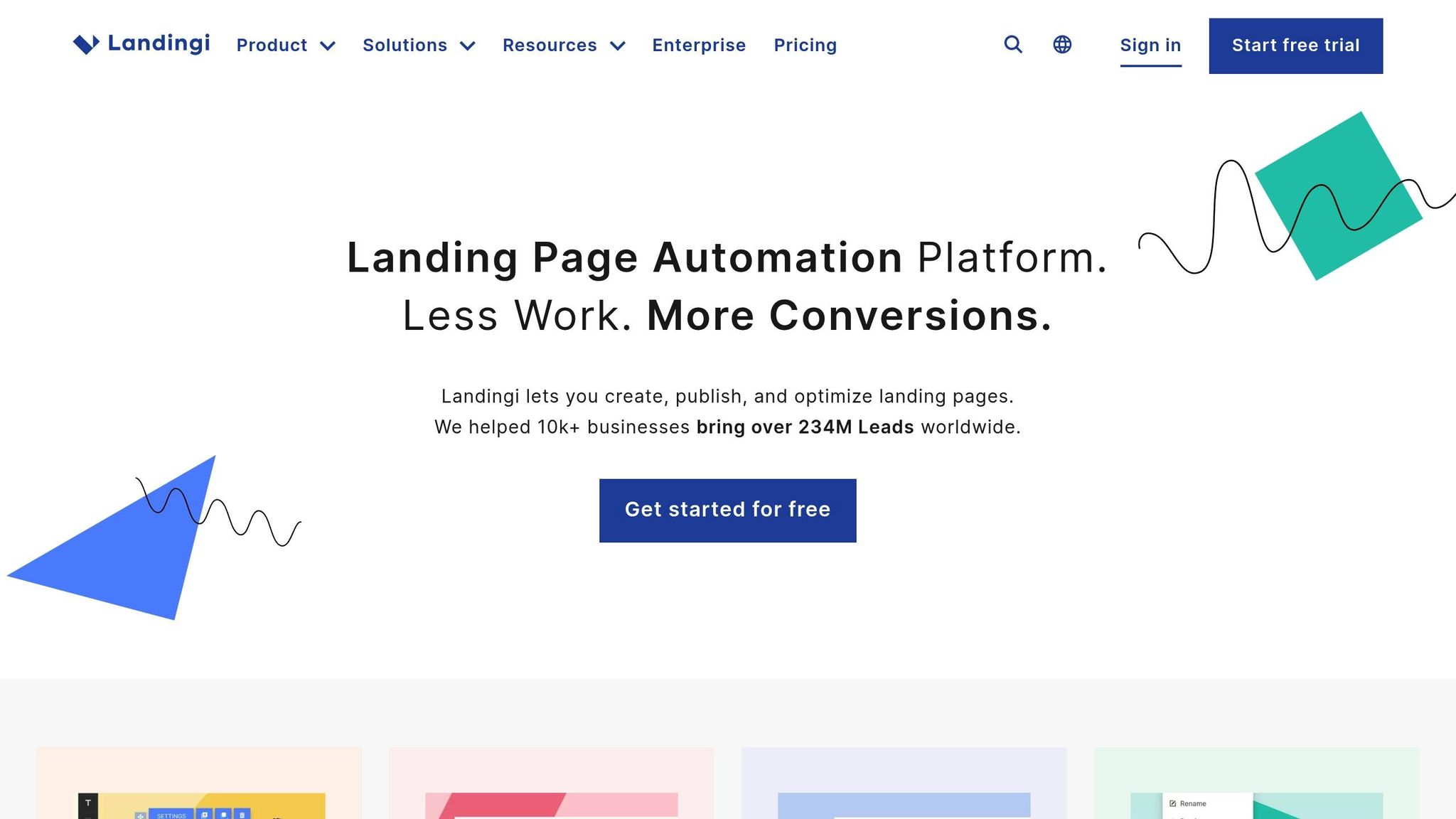
Landingi is a specialized AI landing page builder designed to help businesses maximize conversions in 2025. Here’s a closer look at its standout features, pricing, and how it caters to different users.
AI-Powered Design Features
Landingi comes packed with smart tools to simplify and enhance landing page creation. It includes an AI-powered copy generator to craft compelling text, an AI image editor for fine-tuning visuals, and AI-driven optimization suggestions that analyze your page and recommend tweaks to improve performance. Businesses using these features have reported an average 17% increase in conversions. With a drag-and-drop editor and over 400 templates, creating pages that align with proven strategies becomes straightforward.
Pricing (in USD)
Landingi offers flexible pricing options to suit a range of business needs:
- Free: Includes 1 page, 500 visits/month, and 1 domain.
- Lite: $29/month for 10 pages, 5,000 visits/month.
- Professional: $69/month for unlimited pages, 50,000 visits/month, and up to 10 domains.
- Enterprise: $1,399/month for unlimited pages, unlimited visits, and up to 100 domains.
All paid plans come with a 14-day free trial, and annual subscriptions include a 10% discount.
Use Cases (Target Audience)
Landingi is a versatile tool that fits the needs of various businesses. It’s ideal for small businesses, startups, and enterprises focused on increasing conversions. Marketers and agencies can quickly launch landing pages for campaigns, while e-commerce companies have seen up to a 20% boost in lead generation after applying AI-driven design updates.
Customization and Flexibility
Customization is a strong point for Landingi. Its editor and extensive template library allow users to create tailored designs that match their branding and campaign goals. The platform also integrates smoothly with tools like Mailchimp, HubSpot, and Google Analytics, making it easy to track performance and refine pages as marketing strategies evolve.
sbb-itb-d6d4d8b
7. Writesonic
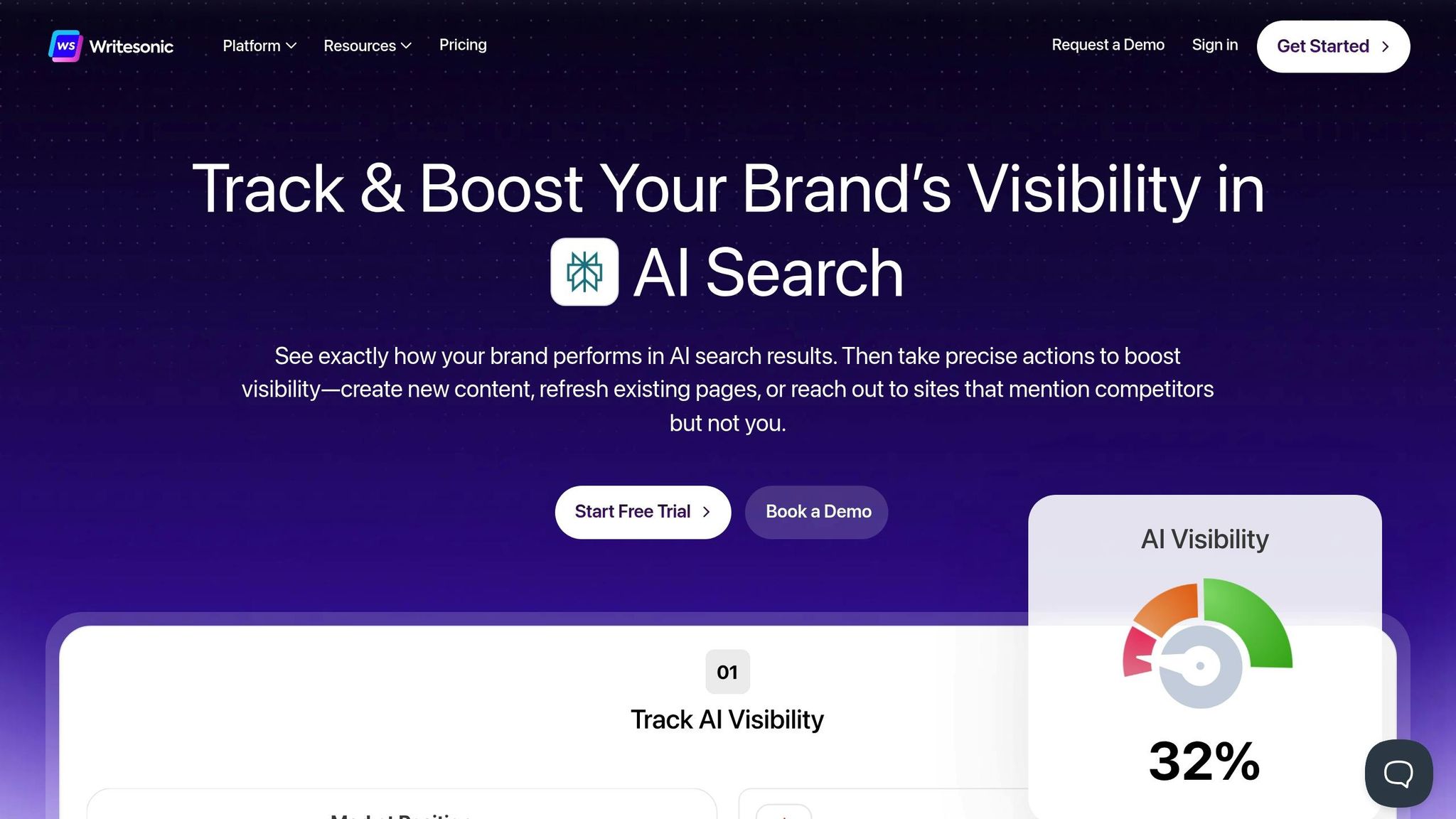
Writesonic uses artificial intelligence to create fully functional landing pages from just a few details. Unlike traditional drag-and-drop builders, it can transform a basic product description or a handful of keywords into a complete landing page. This makes it a great option for businesses that need to launch campaigns quickly and efficiently.
AI-Powered Design Features
At its core, Writesonic combines AI-driven copywriting with smart design tools to craft landing pages tailored to specific audiences. Users simply input their product details, target audience, and tone preferences. From there, Writesonic generates layouts, writes content, and selects from over 100 industry-specific templates. By analyzing successful landing pages, it incorporates strategies proven to boost conversions, such as persuasive messaging and mobile-friendly designs.
One marketing agency reported cutting their design time by 60% and increasing conversions by 25% after using Writesonic’s recommendations.
Pricing (in USD)
Writesonic offers plans starting at $16 per month, using a credit-based system. For advanced features, plans go up to $499 per month. A free trial is also available for those looking to explore the platform before committing. The Basic Plan is ideal for small businesses, while the Enterprise Plan provides added customization options and priority support.
Use Cases (Target Audience)
Writesonic is a great fit for digital marketers, small business owners, entrepreneurs, and agencies that need landing pages without the need for extensive design or writing expertise. It shines in time-sensitive situations, such as product launches, seasonal promotions, or A/B testing of multiple page variations. E-commerce brands and SaaS companies, in particular, will appreciate its ability to quickly generate product-focused landing pages.
Customization and Flexibility
While Writesonic automates much of the process, it still allows users to fine-tune the final product. You can add your brand guidelines and specify tone preferences to ensure the output aligns with your style. The built-in editor lets you tweak AI-generated elements, and it integrates seamlessly with popular marketing platforms. Users consistently praise its intuitive interface and the quality of its AI-generated content, with the platform earning an average rating of 4.7 out of 5. However, businesses in niche industries might need to make some manual adjustments to meet their specific needs.
Next, we’ll explore how Writesonic’s approach complements the other landing page tools on our list.
8. Lovable
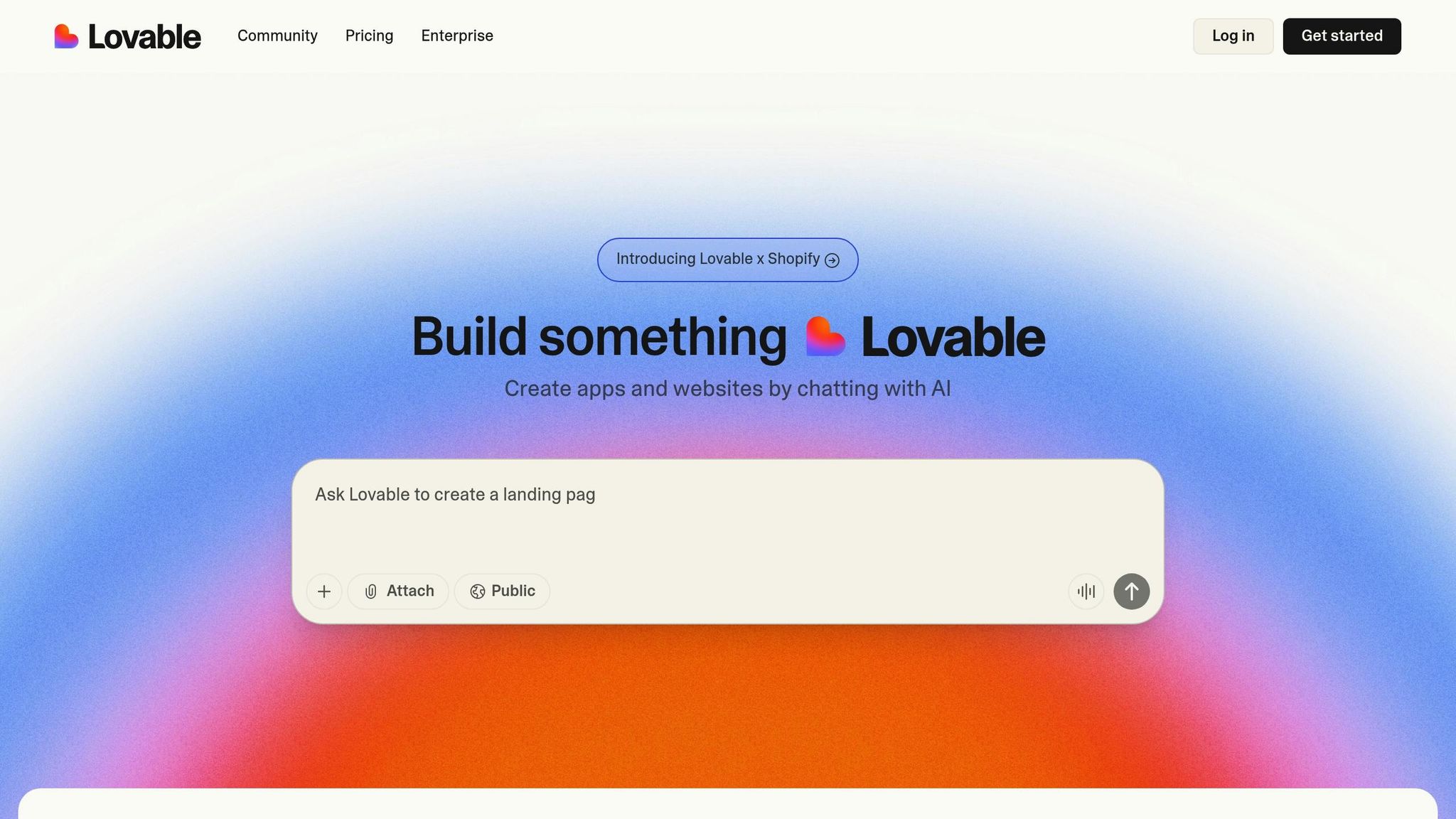
Lovable is an AI-powered landing page tool that takes a completely automated approach to creating professional-looking pages. With just a brief description of your business or campaign goals, it can generate fully designed landing pages in minutes. It’s perfect for anyone who needs fast, polished results without the hassle of manual design.
AI-Powered Design Features
Lovable’s AI handles the entire creation process, from crafting layouts and copy to selecting visuals and designing custom headlines and calls-to-action – all in one seamless workflow. By analyzing your input, it produces designs optimized for conversions, following industry standards for engaging users and generating leads.
The tool stands out by suggesting high-converting design elements and arranging content in ways that work best for your specific industry. This makes it a great fit for those who need results quickly but lack design expertise. Another highlight is its ability to generate multiple page variations instantly, enabling you to test different approaches for the same campaign. Every page is fully responsive, meaning it will look great on any screen size.
Pricing (in USD)
Lovable’s pricing ranges from $17 to $57 per month, with additional enterprise options for larger needs. It likely includes a free trial or basic plan, making it easy to test the platform before committing.
Use Cases (Target Audience)
Lovable is ideal for small businesses, startups, and solopreneurs who need to create landing pages quickly without any technical skills. Its beginner-friendly interface is perfect for those with little to no design experience or for marketers looking to streamline their workflow.
The platform shines in scenarios where speed is critical. Whether you’re launching a new product, running a seasonal promotion, or testing multiple campaign ideas, Lovable helps you save time by delivering professional results in minutes. Marketers and entrepreneurs juggling multiple campaigns will especially appreciate its efficiency.
Customization and Flexibility
Even though Lovable automates most of the process, it offers plenty of customization options. Users can tweak templates with a drag-and-drop editor, adjusting colors, fonts, layouts, and branding elements to align with their vision. You can also upload custom images and connect the platform with other marketing tools.
This combination of automation and flexibility makes Lovable a great choice for those who want the convenience of AI but still need the freedom to tailor their pages. Its ability to balance speed with customization ensures it remains a strong contender among the tools on this list.
9. Hostinger
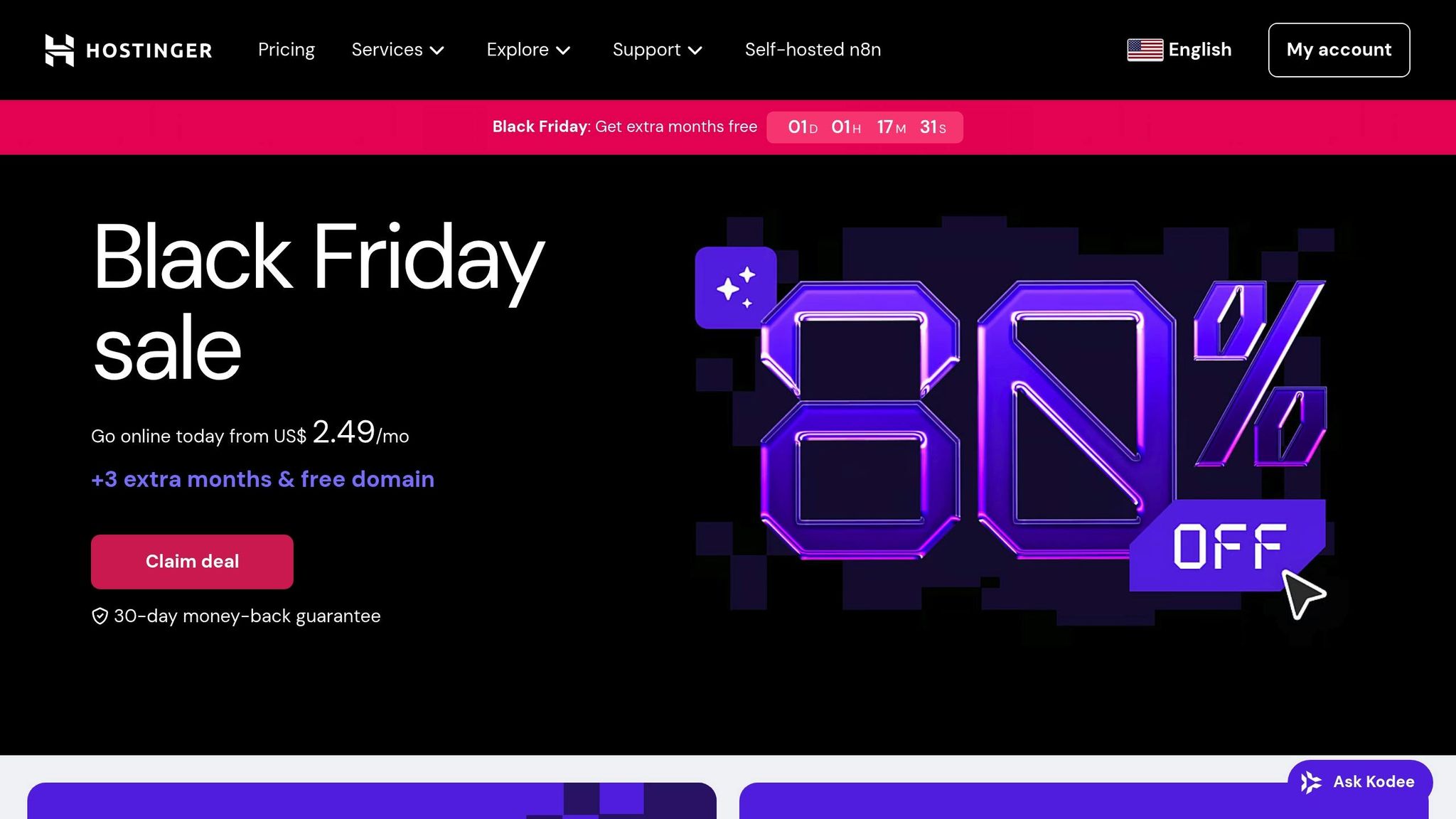
Hostinger takes a streamlined approach to AI-powered landing page creation by embedding its website builder directly into its hosting platform. This setup means you can create, launch, and manage landing pages all from one dashboard – no need to juggle between multiple tools. With over 29 million websites powered by Hostinger as of 2025, the platform has established itself as a reliable and scalable solution. This seamless integration highlights how AI can simplify the process of building landing pages across various platforms.
AI-Powered Design Features
Hostinger’s AI website builder can craft fully functional landing pages based on just a few inputs, like your business type and campaign goals. It suggests layouts, writes relevant copy, and picks images that align with your industry and objectives. Plus, all designs are responsive, so your pages will look great on desktops, tablets, and mobile devices.
Even after the AI does its magic, you’re not locked in. You can tweak the layouts, replace images, or fine-tune the copy to better suit your vision. This blend of automation and manual control means you don’t need technical expertise to get professional results.
Use Cases (Target Audience)
This tool is perfect for small business owners, entrepreneurs, and solopreneurs who need a fast and hassle-free way to establish an online presence without hiring a developer or designer. Agencies managing multiple client sites will also find it useful for streamlining workflows and cutting costs. Startups, too, can benefit from the ability to quickly create and test multiple landing pages for different campaigns – all while staying budget-friendly.
Customization and Flexibility
Hostinger doesn’t just rely on automation; it also offers extensive customization options. You can adjust colors, fonts, layouts, and branding elements to make sure your landing pages truly represent your brand. The platform supports integrations with popular marketing and analytics tools, giving you the ability to track and optimize your campaigns effectively.
Users frequently praise the builder for its ease of use and design quality. On top of that, Hostinger provides 24/7 customer support, along with tutorials and a knowledge base to ensure you get the most out of the platform. Whether you’re a beginner or a seasoned marketer, Hostinger makes it easy to create landing pages that work for you.
10. SiteKickAI
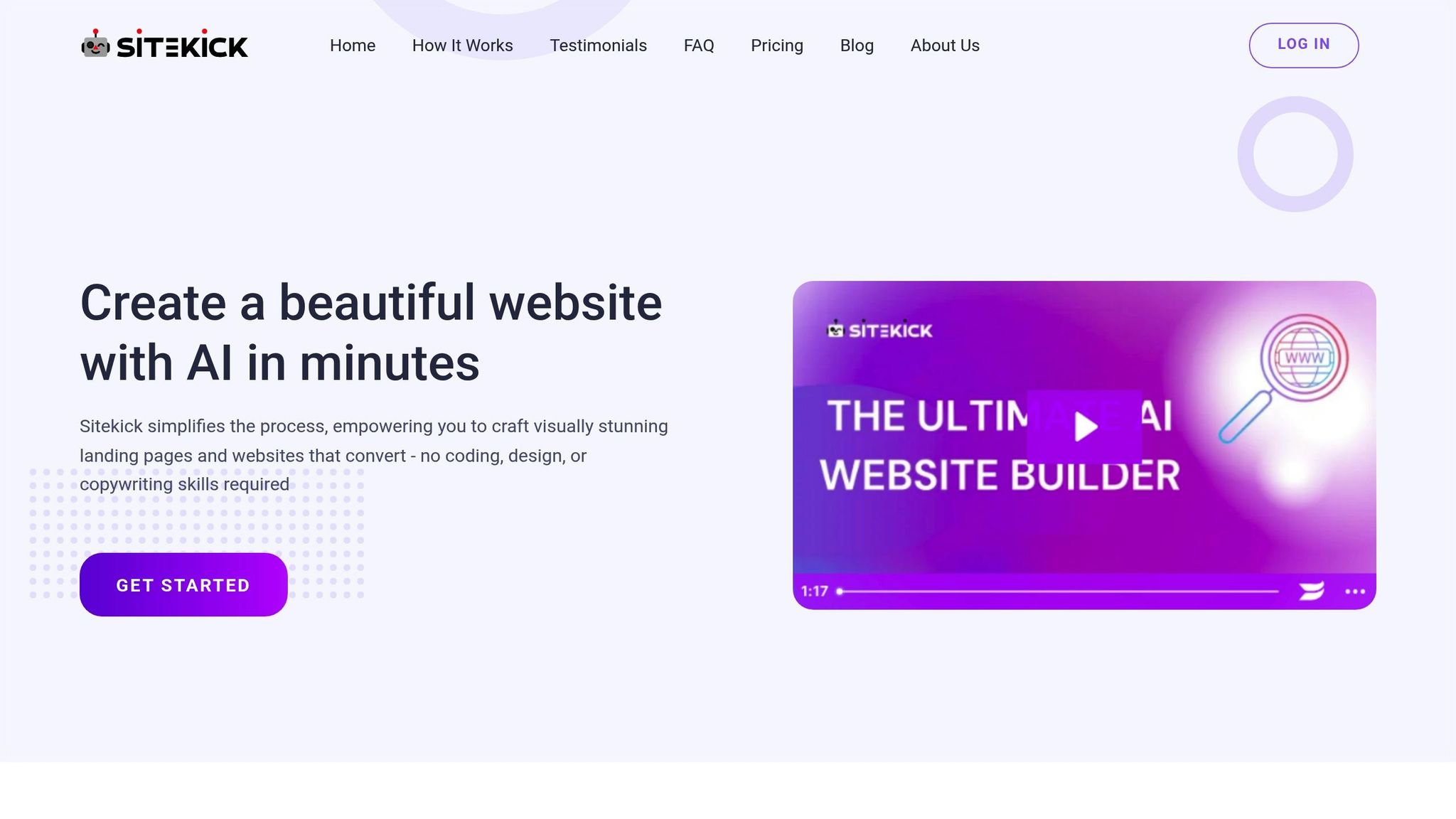
SiteKickAI has carved a niche in the AI landing page builder market by focusing on speed and ease of use. It offers one of the quickest ways to go from concept to a live landing page, making it a go-to option for entrepreneurs, small business owners, and marketers looking to validate ideas or launch campaigns without delay. Its standout feature? A no-login, instant launch process that lets you create and publish a landing page immediately – no account registration required. This streamlined approach sets the foundation for its AI-powered tools.
AI-Powered Design Features
One of SiteKickAI’s defining strengths lies in its ability to generate both copy and design simultaneously. By simply describing your product or service, the platform’s AI combines your input with proven industry practices to craft high-converting landing pages. It doesn’t stop at layout suggestions – it also creates compelling headlines, calls-to-action, selects visuals, and provides real-time optimization tips. This automated process removes the need for advanced design or copywriting skills, ensuring your landing page is built to follow established conversion strategies.
Who Can Benefit?
SiteKickAI is perfect for entrepreneurs, small business owners, and digital marketers who need to launch landing pages quickly without navigating technical hurdles. Whether you’re a startup testing new marketing ideas, a marketer juggling multiple campaigns, or an e-commerce business rolling out a promotional page, this tool delivers speed and efficiency. It’s equally useful for consultants, coaches, and service providers who need straightforward landing pages for lead generation.
Customization Options
While SiteKickAI excels in rapid page creation, it also offers flexibility through its drag-and-drop editor. You can tweak layouts, adjust colors, change fonts, and edit content blocks to match your brand’s style. Start with AI-generated templates and refine them to suit your needs. However, if you’re looking for deep customization, intricate integrations, or advanced analytics, the platform’s simplified approach might feel limiting. That said, it supports integration with popular tools like Google Analytics, Mailchimp, and other CRM systems, allowing you to seamlessly incorporate it into your existing workflow while enjoying the speed of its page-building process.
Tool Comparison Chart
Here’s a quick comparison of top AI landing page tools, breaking down their features, pricing, best applications, and potential drawbacks.
| Tool | Key Features | Pricing (USD/month) | Best Use Cases | Main Limitations |
|---|---|---|---|---|
| Team-GPT | AI-powered collaboration, team workflows, shared prompts | $10-$25 | Teams working on collaborative AI content | Lacks landing page-specific tools |
| PageGPT | AI page generation, chat-based design, instant deployment | $19-$49 | Solo entrepreneurs, quick page creation | Limited customization options |
| Canva | User-friendly design, extensive templates, AI Magic Write | Free-$15 | Small businesses, visually rich campaigns | Few conversion-focused tools |
| Unbounce | Smart Traffic AI, dynamic text replacement, A/B testing | $99-$249+ | Marketers focused on conversions, agencies | No free plan, high starting cost |
| MailerLite | Drag-and-drop builder, email integration, automation | Free-$50 | Lead generation, email marketing campaigns | Lacks advanced landing page functionality |
| Landingi | AI design suggestions, 400+ templates, copy/image generation | Free-$1,399 | SMBs, agencies, conversion-driven projects | Free plan limitations, steep pricing tiers |
| Writesonic | AI copywriting, SEO optimization, content generation | $16-$499 | Quick content creation, content-heavy pages | Limited design flexibility |
| Lovable | AI design automation, modern templates | $29-$99 | Design-focused projects, creative agencies | Fewer integrations, newer platform |
| Hostinger | AI website builder, hosting included, domain integration | $2.99-$8.99 | All-in-one solution for budget users | Basic AI tools, limited scalability |
| SiteKickAI | Instant launch without login, AI copy + design | $19-$79 | Rapid deployment, idea validation | Minimal deep customization options |
This chart is a handy guide to identify which tool aligns best with your campaign needs.
Pricing and Features
The pricing spectrum is vast, ranging from $2.99 for budget-friendly options like Hostinger to enterprise-level rates of $1,399 for tools like Landingi. For those prioritizing advanced conversion tools, Unbounce and Landingi stand out. They include features such as Smart Traffic routing and dynamic content suggestions, along with A/B testing and in-depth analytics – perfect for landing page specialists.
For users focused on speed, SiteKickAI and PageGPT are excellent. SiteKickAI allows instant publishing without requiring a login, while PageGPT simplifies workflows with its chat-based design system. Both are ideal for users who need to deploy quickly without worrying about extensive customization.
Budget-Friendly Options
If you’re looking to save, platforms like Canva, MailerLite, and Landingi offer free plans or trials. Canva is particularly useful for visually driven campaigns, while MailerLite integrates seamlessly with email marketing efforts. Keep in mind that free plans often come with restrictions, such as visitor limits or reduced customization options.
Integration and Scalability
Integration capabilities can be a game-changer. MailerLite is a strong choice for email marketing connections, while Unbounce and Landingi provide robust CRM and analytics integrations. On the other hand, Hostinger offers built-in hosting, which simplifies setup for beginners but lacks connections to advanced marketing tools.
When selecting a tool, consider your expected monthly traffic. For example, Landingi’s free plan may limit visitors, while Unbounce’s higher tiers support unlimited traffic. Choosing the right plan upfront can help avoid surprise upgrade costs as your campaign scales.
JeffLizik.com Resource Highlight
While AI tools excel in handling the technical aspects of landing page design and deployment, JeffLizik.com takes things further by offering tailored digital marketing consulting to optimize these AI-driven solutions. Their expertise bridges the gap between cutting-edge technology and strategic implementation, ensuring your landing pages perform at their best.
One standout feature of their consulting is the use of trigger-based conversion paths. These paths adapt in real time to visitor behavior, transforming your landing pages from static designs into dynamic, responsive tools. This approach moves away from outdated, one-size-fits-all strategies and ensures your pages actively engage with users.
Another key focus is semantic content optimization. Instead of relying on outdated keyword-stuffing practices, JeffLizik.com prioritizes intent-driven, contextually relevant content. This ensures your landing pages use natural language patterns that work seamlessly with AI tools, improving both user experience and search engine performance.
Their 12-month strategic marketing plans provide a roadmap for scaling and optimizing your landing page efforts. These plans incorporate predictive analytics to map customer journeys, allowing you to anticipate user needs and boost engagement rates across all campaigns.
JeffLizik.com also offers an AI-powered newsletter designed to keep you informed. This personalized newsletter curates industry insights and top articles based on your reading habits, ensuring you stay up-to-date with the latest AI tools and landing page strategies. By tailoring content to your specific business needs, the newsletter delivers actionable information that aligns with your goals.
For businesses using platforms like Unbounce or Landingi, JeffLizik.com’s content optimization techniques are particularly valuable. Their approach focuses on creating landing pages that adapt to user interactions, maximizing the potential of your AI platform and driving higher conversions.
Additionally, U.S.-based businesses can benefit from consultations tailored to meet domestic standards, ensuring a smooth and effective integration of these strategies. JeffLizik.com’s expertise complements the AI tools mentioned earlier, making them a valuable resource for businesses looking to elevate their landing page performance.
Conclusion
AI tools have reshaped the way businesses approach landing page design, making the process faster and more efficient while delivering measurable results. With some platforms, users can simply describe their ideal landing page in plain English and watch it come to life almost instantly. What once took weeks can now be accomplished in mere minutes.
The benefits for lead generation are particularly impressive. Take Landingi, for instance – its AI optimization features have helped businesses achieve an average 17% boost in conversion rates compared to those not using the tool. Features like smart copy generation, dynamic personalization, and behavior-driven conversion paths directly contribute to better marketing performance. These advancements make AI tools relevant across industries, offering solutions for a variety of challenges.
Whether it’s enabling seamless team collaboration or simplifying the publishing process, these platforms cater to businesses of all sizes. For small businesses, affordable options like Hostinger’s AI website builder start at just $2.99 per month. Meanwhile, larger organizations can take advantage of more advanced features with Landingi’s Professional plan at $69 per month, which includes higher visitor limits and robust optimization tools. This accessibility means even businesses with limited resources can now compete with larger players in the market.
Cost savings are another major advantage. DIY landing pages created with AI tools can cost as little as $50, a stark contrast to the $500–$2,000 typically charged by freelance designers. This not only reduces expenses but also saves time, allowing teams to focus on strategic priorities without sacrificing quality.
As digital marketing evolves, AI tools offer a clear competitive edge by streamlining workflows, enhancing lead generation, and improving customer targeting. Considering that 77% of marketers recognize landing pages as critical to their lead generation efforts, adopting these AI-powered solutions is quickly becoming a necessity for staying ahead in 2025.
To get started, assess your business needs and budget, then explore the free trials and entry-level plans available from most platforms. Find the tool that aligns with your marketing goals and start leveraging its capabilities.
AI has already revolutionized landing page design – now it’s your turn to use these advancements to elevate your marketing strategy. Embrace these tools to drive results and take your business to the next level. The future of landing page design is here, and it’s powered by AI.
FAQs
How can AI tools help improve landing page conversion rates compared to traditional design methods?
AI tools have the power to boost landing page conversion rates by streamlining and improving essential design elements. Instead of relying on traditional approaches, AI dives into user behavior, preferences, and trends to craft designs that truly connect with your audience.
For instance, AI can run A/B tests on various layouts, headlines, and calls-to-action to pinpoint the most effective combinations. It can also create personalized content, speed up load times, and recommend design tweaks using real-time analytics. All these enhancements work together to drive better engagement and increase conversions.
What should I look for in an AI tool to create the perfect landing page?
When choosing an AI tool for creating landing pages, it’s important to focus on features that match your objectives. Look for tools that specialize in content optimization, ensuring your page speaks directly to user intent while using natural, engaging language. Platforms offering dynamic content customization are also key, as they allow your landing page to adjust based on user behavior and preferences.
You’ll also want to think about how easy the tool is to use, how well it integrates with your current systems, and whether it fits within your budget. Tools with user-friendly interfaces and AI-driven insights can streamline your workflow and help you achieve polished, professional results.
What are some potential drawbacks of using AI tools for designing landing pages?
AI tools for landing page design can be a huge time-saver and simplify workflows, but they aren’t without their challenges. One of the main drawbacks is that these tools may struggle to match the nuanced creativity or brand-specific touches that a skilled human designer brings to the table. Plus, many AI tools rely on pre-set templates, which, if not customized thoughtfully, can lead to designs that feel generic or uninspired.
Another factor to keep in mind is the importance of quality input. If your goals are unclear or the information provided is incomplete, the results may fall short of expectations. On top of that, advanced AI features often come with a higher price tag. This means businesses need to carefully evaluate whether the potential benefits justify the cost and if it fits within their budget and overall strategy.
